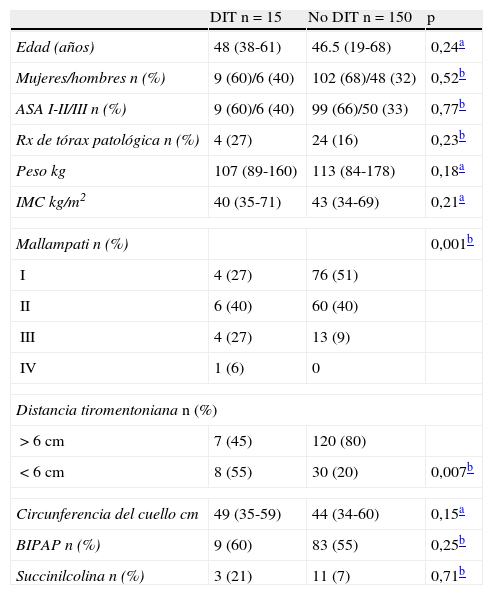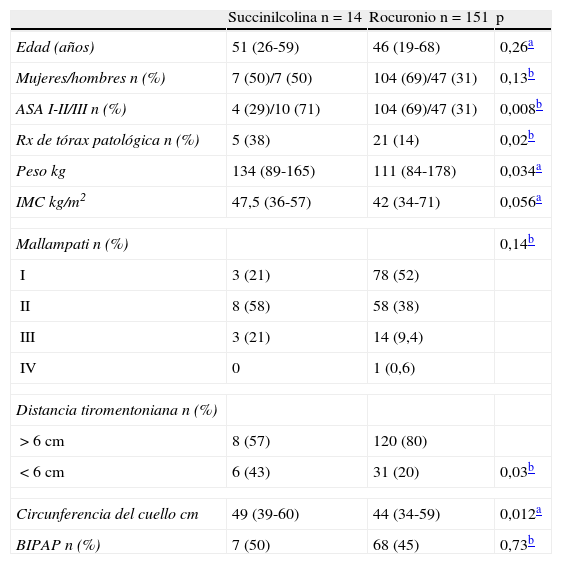Determinar la incidencia de dificultad de intubación traqueal (DIT) en pacientes obesos operados de cirugía bariátrica y valorar los factores predictivos. El objetivo secundario fue determinar los factores que influyeron en la elección del bloqueante neuromuscular (succinilcolina o rocuronio).
MétodosEstudio observacional, prospectivo en pacientes consecutivos de cirugía bariátrica. Se efectuó la intubación traqueal mediante laringoscopia directa con un tubo traqueal con fiador. Se consideró DIT cuando se observó un grado en la clasificación de Cormack-Lehane III-IV o fue necesario aplicar el algoritmo para DIT (laringoscopia con guía Frova y, en caso de no poder intubar, videolaringoscopio Airtraq). Si con estas medidas no era posible la intubación traqueal, se administró sugammadex en aquellos pacientes con rocuronio y posteriormente se realizó la intubación traqueal con anestesia local y fibroscopio.
ResultadosSe incluyó a a 166 pacientes. En un caso se realizó la intubación con fibroscopio. De los 165 pacientes restantes, en 14 pacientes se utilizó la succinilcolina y en 151, el rocuronio. Quince pacientes presentaron DIT (9%): en 4 fue necesario el Airtraq; de ellos, uno requirió sugammadex y fue posteriormente intubado con fibroscopio. La incidencia de intubación con fibroscopio fue del 1,2% (IC 95%; 0,3-4%). La DIT se asoció a los grados de Mallampati 3-4 (odds ratio: 3 [IC 95%; 1,37-6,8], sensibilidad 33%, especificidad 91%) y a la distancia tiromentoniana <6cm (odds ratio: 4,8 [IC 95%; 1,45-16]; sensibilidad 53%; especificidad 79%).
ConclusiónEl protocolo de rescate de DIT con Frova y Airtraq evitó el rescate con sugammadex excepto en un caso.
To determine the incidence of difficult tracheal intubation (DTI), as well as predictive factors for DTI and what influences the choice of the neuromuscular blocking agent (succinylcholine or rocuronium).
MethodsThis is an observational, prospective study on consecutive bariatric surgery patients. Tracheal intubation was performed by direct laryngoscopy with a preformed tracheal tube. DTI was considered when there was a Cormack-Lehane classification of iii-iv or when it was necessary to apply the DTI algorithm, which consisted in the use of Frova guide, and Airtraq video-laryngoscope as second choice, and finally awaking the patient and sugammadex reversal if rocuronium was the selected neuromuscular blocking agent. Thereafter, tracheal intubation was performed using an awake fibroscopic technique
ResultsOne hundred and sixty six patients were included. In one case, conscious fiberscope tracheal intubation was performed. Succinylcholine was selected for 14 patients, and rocuronium for 151 patients. Fifteen patients had a DTI (9%): in 4 Airtraq was deemed necessary. One patient received sugammadex to reverse neuromuscular blockade. Conscious tracheal intubation represented 1.2% (95% CI; 0.3-4%). DTI was associated with Mallampati score of 3-4 (odds ratio, 3 [95% CI; 1.37-6.8], sensitivity of 33%, specificity of 91%) and with thyromental distance<6cm (odds ratio, 4.8 [95% CI; 1.45-16]; sensitivity of 53%; specificity of 79%).
ConclusionRescue airway protocol with Frova and Airtraq avoided the use of sugammadex, except in one patient.
Artículo
Comprando el artículo el PDF del mismo podrá ser descargado
Precio 19,34 €
Comprar ahora









